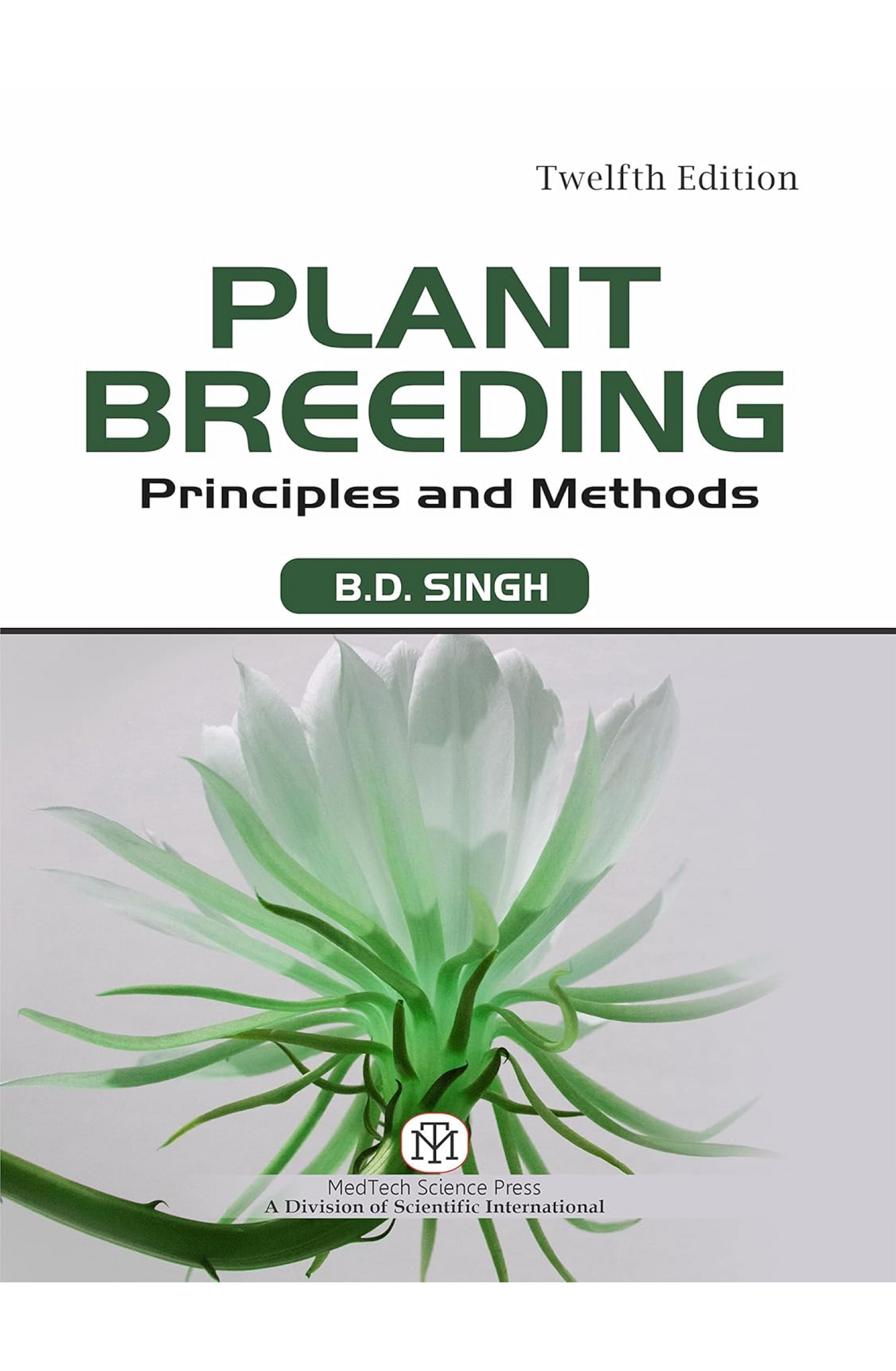Plant Breeding Principles and Methods 12th Latest Edition by B.D. Singh
Plant Breeding Principles and Methods 12th Latest Edition by B.D. Singh
Save Extra:
GET 2% instant discount at Checkout. Min purchase is 299
GET 5% instant discount at Checkout. Min purchase is 799
FREE Shipping on orders above Rs.299
Add Gift Card and get 5% more discount on Next purchase
Couldn't load pickup availability
Product details
Publisher : Medtech Science Press
Author : B.D. Singh
Language : English
Edition : 12th Edition
ISBN-10 :
ISBN-13 :
The book Plant Breeding: Principles and Methods was initially designed for B. Sc. (Ag.) students of Indian Universities, and it was extremely well-received by the entire plant breeding community. Gradually, it evolved to its present form, which provides up-to-date information on both conventional and modern approaches to crop improvement. The book has 45 chapters, which are organized in ten parts, and cover various aspects of germplasm conservation and utilization, breeding of self- and cross-pollinated as well as clonal crops, breeding for resistance to biotic and abiotic stresses, special breeding approaches like ide type, improved quality, polyploidy, biotechnology, molecular markers, etc., evaluation and multiplication of improved strains, national and international organizations for crop improvement, and intellectual property rights. In this edition, two new chapters, viz., ‘Novel Plant Breeding Tools’ and ‘Plant Breeding in Private Sector Environment – Seed Industry at A Glance for the New Entrant/Aspirant’, have been added to enhance the usefulness of the book. This enlarged edition is expected to be immensely useful to all plant breeding students.
Content :
Part I: General Consideration
1. Introduction to Plant Breeding 1
1.1 Introduction 1
1.2 History of Plant Breeding 2
1.3 History of Plant Breeding in India 4
1.4 Nature of Plant Breeding 4
1.5 The Disciplines a Breeder Ought to Know 5
1.6 Objectives of Plant Breeding 5
1.7 Activities in a Plant Breeding Programme 6
1.8 Some Important Achievements 7
1.8.1 Semidwarf Wheat and Rice 7
1.8.2 Noblisation of Indian Canes 8
1.8.3 Hybrid Millets 8
1.8.4 Hybrid Cotton 9
1.8.5 Molecular Breeding 9
1.8.6 Transgenic Varieties 9
1.9 Undesirable Consequences 10
1.9.1 Genetic Erosion 10
1.9.2 Narrow Genetic Base 10
1.9.3 Increased Susceptibility to Minor Diseases 11
1.9.4 Yield Plateau 11
1.10 Breeding for Climate Change 11
1.11 Iconic and Mega Varieties 12
1.12 Commercial Plant Breeding 12
1.13 Future Prospects 14
Questions 14
Suggested Further Readings 15
2. Domestication and Germplasm Conservation 16
2.1 Introduction 16
2.2 Domestication 16
2.2.1 Selection under Domestication 17
2.2.1.1 Natural Selection 17
2.2.1.2 Artificial Selection 17
2.2.2 Types of Selection 17
2.2.2.1 Directional Selection 18
2.2.2.2 Stabilizing Selection 18
2.2.2.3 Disruptive Selection 18
2.2.3 Changes in Plant Species under Domestication 18
2.3 Patterns of Evolution in Crop Plants 20
2.3.1 Mendelian Variation 21
2.3.2 Interspecific Hybridisation 21
2.3.3 Polyploidy 21
2.3.4 Models of Domestication 22
2.4 Germplasm 22
2.4.1 Land Races 23
2.4.2 Obsolete Varieties 23
2.4.3 Varieties in Cultivation 23
2.4.4 Breeding Lines 23
2.4.5 Special Genetic Stocks 23
2.4.6 Wild forms and Wild Relatives 23
2.5 Gene Pool Concept 23
2.6 Genetic Erosion 24
2.7 Germplasm Conservation 24
2.7.1 In Situ Germplasm Conservation 25
2.7.1.1 Merits 25
2.7.1.2 Demerits 25
2.7.2 Ex Situ Germplasm Conservation 25
2.7.2.1 Seed Gene Banks 25
2.7.2.2 Field Gene Banks 26
2.7.2.3 Shoot-Tip Gene Banks 26
2.7.2.4 Cell and Organ Gene Banks 27
2.7.2.5 DNA Banks 28
2.7.3 Activities in Germplasm Conservation 28
2.8 Collection of Germplasm 28
2.8.1 Exploration and Collection 28
2.8.1.1 Objectives 28
2.8.1.2 Areas of Collection 28
2.8.1.3 Sampling Sites 28
2.8.1.4 Collection Priorities 28
2.8.1.5 Sampling Procedure 29
2.8.1.6 Sample Size 29
2.8.1.7 Field Records 29
2.8.1.8 Merits of Exploration 29
2.8.1.9 Limitations of Plant Explorations 29
2.8.2 Procurement from other Agencies 29
2.9 Centres of Origin 30
2.9.1 The China Centre of Origin 31
2.9.2 The Hindustan Centre of Origin 32
2.9.3 The Central Asia Centre of Origin 32
2.9.4 The Asia Minor Centre of Origin 32
2.9.5 The Mediterranean Centre of Origin 32
2.9.6 The Abyssinian Centre of Origin 32
2.9.7 The Central American Centre of Origin 32
2.9.8 The South American Centre of Origin 33
2.9.9 Centres of Diversity 33
2.10 Gene Banks 34
2.10.1 Requisites for a Gene Bank 38
2.10.2 Management of Gene Banks 38
2.10.3 Genetic Erosion in Gene Banks 39
2.10.4 Core Collection 39
2.10.5 Constraints of Gene Banks 40
2.11 Germplasm Regeneration 40
2.12 Germplasm Evaluation 41
2.13 Germplasm Cataloguing, Data Storage and Retrieval 41
2.14 Germplasm Multiplication and Distribution 42
2.15 Germplasm Utilisation 42
2.16 Indian Plant Genetic Resources Management System 43
2.16.1 Mandate of NBPGR 43
2.16.2 Regional Stations of NBPGR 44
2.16.3 Exploration Base Centres of NBPGR 45
2.17 International Cooperation and Agreements 45
2.17.1 The International Undertaking on Plant Genetic Resources (1983) 45
2.17.2 International Code of Conduct for Collection and Transfer of PGRs 45
2.17.3 Global System for the Conservation and Utilisation of PGRs 45
2.18 Future Activities 46
Questions 46
3. Plant Introduction 47
3.1 Introduction 47
3.2 Types of Plant Introduction 47
3.2.1 Primary Introduction 47
3.2.2 Secondary Introduction 47
3.3 History of Plant Introduction 48
3.4 Plant Introduction Agencies in India 48
3.5 Procedure for Plant Introduction 49
3.5.1 Procurement of Germplasm 49
3.5.1.1 Gift, Purchase or Collection 49
3.5.1.2 Propagules 50
3.5.1.3 Restrictions on Export and Introduction of Plant Materials 50
3.5.2 Quarantine 50
3.5.2.1 Plant Produce Imported in Bulk for Consumption, Sowing or Planting 50
3.5.2.2 Plant Produce Imported as Small Samples for Cultivation and Research 51
3.5.2.3 Quarantine Procedure 51
3.5.3 Cataloguing, Evaluation, Multiplication and Distribution 52
3.6 Acclimatisation 52
3.7 Purpose of Plant Introduction 52
3.8 Important Achievements 53
3.8.1 New Crop Species 53
3.8.2 Direct Release as Varieties 53
3.8.3 Varieties Selected from Introductions 53
3.8.4 Varieties Developed through Hybridisation 53
3.9 Merits of Plant Introduction 53
3.10 Demerits of Plant Introduction 54
Questions 54
Suggested Further Readings 55
4. Modes of Reproduction in Crop Plants 56
4.1 Introduction 56
4.2 Asexual Reproduction 56
4.2.1 Vegetative Reproduction 56
4.2.1.1 Underground Stems 56
4.2.1.2 Sub-aerial Stems 56
4.2.1.3 Bulbils 56
4.2.1.4 Artificial Vegetative Reproduction 57
4.2.1.5 Significance of Vegetative Reproduction 57
4.2.2 Apomixis 57
4.2.2.1 Adventive Embryony 57
4.2.2.2 Gametophytic Apomixis 57
4.2.2.3 Significance of Apomixis 58
4.3 Sexual Reproduction 58
4.3.1 Flower 58
4.3.2 Sporogenesis 58
4.3.2.1 Microsporogenesis 58
4.3.2.2 Megasporogenesis 58
4.3.3 Gametogenesis 58
4.3.3.1 Microgametogenesis 60
4.3.3.2 Megagametogenesis 60
4.3.4 Fertilisation 60
4.3.5 Alternation of Generations 60
4.3.6 Significance of Sexual Reproduction 60
4.4 Anthesis 60
4.5 Mode of Pollination 61
4.5.1 Self-Pollination 61
4.5.1.1 Mechanisms Promoting Self-Pollination 63
4.5.1.2 Genetic Consequences of Self-Pollination 63
4.5.2 Cross-Pollination 63
4.5.2.1 Mechanisms Promoting Cross Pollination 63
4.5.2.2 Genetic Consequences of Cross-Pollinations 64
4.5.3 Often Cross-Pollinated Species 64
4.6 Determination of Mode of Pollination 64
4.7 Determination of Amount of Cross-Pollination 65
4.8 Detection of Apomixis 65
4.9 Relevance of Mode of Reproduction 65
4.9.1 Genetic Constitution 65
4.9.2 Nature of Gene Action 66
4.9.3 Facility in Controlled Pollination 66
4.9.4 Genetic Features of the Cultivated Varieties 66
4.9.5 Stability of Varieties after Release 66
4.9.6 The Method for Germplasm Conservation 67
Questions 67
5. Pollination Control: I. Self-Incompatibility and Apomixis 68
5.1 Introduction 68
5.2 Self-Incompatibility 68
5.2.1 Complementary System of Self-Incompatibility 68
5.2.2 Oppositional System of Self-Incompatibility 68
5.3 Heteromorphic System 69
5.4 Homomorphic System 70
5.4.1 Gametophytic System 70
5.4.1.1 Monofactorial Gametophytic System 70
5.4.1.2 Bifactorial Gametophytic Self-Incompatibility 72
5.4.2 Sporophytic System 73
5.5 Molecular Basis of Self-Incompatibility 75
5.5.1 S-Haplotype 75
5.5.2 SI Mechanism in Cruciferae 76
5.5.3 The Solanaceae Type SI Mechanism 76
5.5.4 The Papaveraceae Type SI Mechanism 76
5.6 Interactions Between S Alleles 76
5.6.1 Dominance 77
5.6.2 Competitive Interaction 77
5.7 Relevance of Self-Incompatibility 77
5.8 Elimination of Self-Incompatibility 78
5.9 Temporary Suppression of Self-Incompatibility 79
5.9.1 Bud Pollination 79
5.9.2 Surgical Techniques 79
5.9.3 End-of-Season Pollination 79
5.9.4 High Temperature 79
5.9.5 Increased CO2 Concentration 79
5.9.6 High Humidity 80
5.9.7 Salt (NaCI) Sprays 80
5.9.8 Irradiation 80
5.9.9 Double Pollination 80
5.10 Apomixis 80
5.10.1 The Ideal Apomictic System 80
5.10.2 Genetics of Apomixis 81
5.10.3 Development of Apomictic Lines 81
5.10.3.1 Gene Transfer from Wild Species 81
5.10.3.2 Induced Mutations 81
5.10.3.3 Isolation of Apomictic Recombinants from Interspecific Crosses 81
5.10.4 Applications of Apomixis 82
5.10.4.1 Fixation of Heterosis 82
5.10.4.2 Production of Homozygous Lines 82
5.10.4.3 Production of Vybrids 82
5.10.5 Advantages of Apomixis 82
5.10.6 Problems in Utilisation of Apomixis 83
Questions 83
6. Pollination Control: II. Male Sterility 84
6.1 Introduction 84
6.2 Phenotypic Expression of Male Sterility 84
6.3 Genetic Male Sterility 84
6.3.1 Origin of ms Alleles 85
6.3.2 Site of Action of ms Alleles 85
6.3.3 Molecular Mechanism of ms Action 85
6.3.4 Types of Genetic Male Sterility 86
6.3.4.1 Temperature-Sensitive Genetic Male Sterility 86
6.3.4.2 Photoperiod-Sensitive Genetic Male Sterility (PGMS) 87
6.3.5 Transgene-Based Maintenance of Nontransgenic Genetic Male Sterile Lines 88
6.4 Transgenic Male Sterility/Pollination Control 89
6.4.1 barnase-barstar System 90
6.4.2 Inducible Transgenic Male Sterility 91
6.4.3 Achievements 91
6.5 Cytoplasmic Male Sterility 92
6.6 Cytoplasmic-Genetic Male Sterility 93
6.6.1 Development of New CMS and Restorer Lines 95
6.5.2 Photoperiod-Sensitive Cytoplasmic-Genetic Male Sterility 98
6.5.3 Utilisation in Plant Breeding 98
6.6 Origin of Male Sterile Cytoplasm 99
6.6.1 Spontaneous Mutation 99
6.6.2 Interspecific Cytoplasm Transfers 99
6.6.3 Mutation Induction by Ethidium Bromide 100
6.7 Limitations of Cytoplasmic-Genetic Male Sterility 100
6.7.1 Undesirable side-effects of male sterile cytoplasm 100
6.7.2 Lack of or Unsatisfactory Fertility Restoration 100
6.7.3 Unsatisfactory Pollination 100
6.7.4 Pollen Shedders in CMS Lines 100
6.7.5 Modifying Genes
About The Author :
Brahma Deo Singh, Ex-Emeritus Professor, School of Biotechnology, Banaras Hindu University, Varanasi, India, obtained his Bachelor’s degree in agriculture from Allahabad Agricultural Institute, Allahabad, India and Master’s degree in Agricultural Botany from Govt. Agricultural College, Kanpur, India with first position in the university, and was awarded the University Gold Medal. He obtained his Ph.D. degree from University of Saskatchewan, Saskatoon, Canada. Prof. Singh has 40 years of teaching and research experience in the area of genetics, plant breeding and plant biotechnology with research interests in genetics and breeding of pulse crops, plant tissue culture, biological nitrogen fixation, and molecular markers. He has published over 160 research papers in reputed journals and authored more than two dozen books in genetics, plant breeding and biotechnology. He was awarded the First Prize of the Dr. Rajendra Prasad Puraskar in 1987 and 1990 by the Indian Council of Agricultural Research, New Delhi for the books Padap Prajanan and Anuvanshiki, respectively
Materials
Materials
Paper
Shipping & Refunds
Shipping & Refunds
Share



